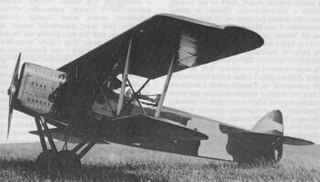
The Aero A.11 was a biplane light bomber and reconnaissance aircraft built in Czechoslovakia between the First and Second World Wars. It formed the basis for many other Czechoslovakian military aircraft of the inter-war period. Around 250 were built, with some remaining in service at the outbreak of World War II.

The Aero A.14 was a Czechoslovakian biplane military reconnaissance aircraft built in the 1920s. It was essentially a slightly modified version of the Hansa-Brandenburg C.I aircraft that Aero had built during World War I as the Ae.10, and for this reason, the aircraft is sometimes referred to as the A.14 Brandenburg. When equipped with a slightly different engine, the aircraft was designated A.15 instead. The two versions were otherwise almost identical.
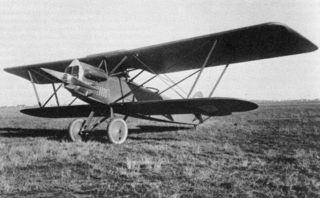
The Aero A.30 was a biplane light bomber and reconnaissance aircraft built in Czechoslovakia in the late 1920s. It originated as an attempt by Aero to improve the performance of the Aero A.11, but soon evolved into quite a different aircraft, larger and more powerful than its predecessor. The aircraft is readily distinguished from other related types by the difference in spans between its wings – the upper set being of much greater span than the lower.

The Aero A.32 was a biplane built in Czechoslovakia in the late 1920s for army co-operation duties including reconnaissance and tactical bombing. While the design took the Aero A.11 as its starting point, the aircraft incorporated significant changes to make it suited for its new low-level role.

The Aero A.100 was a biplane light bomber and reconnaissance aircraft built in Czechoslovakia during the 1930s. It was the final step in a design lineage that extended back to the Aero A.11 a decade earlier. A.100s remained in service throughout World War II and for a few years postwar.

The Aero A.200 was a sportsplane of Czechoslovakia, designed and built specifically to compete in Challenge 1934, the European touring plane championships. It was a four-seater low-wing monoplane.

The Aero A.304 was a Czechoslovakian bomber aircraft that first flew in 1937. It had originally been developed as an airliner, the A.204, but when Aero could not find buyers for the design, it was militarised and successfully marketed to the Czechoslovak Air Force.
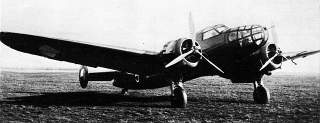
The Aero A.300 was a Czechoslovak bomber aircraft that first flew in 1938 as a much refined development of the A.304. It was designed by Aero to meet a requirement for a bomber-reconnaissance aircraft for the Czechoslovak Air Force, the Aero A-304 transport/bomber formed the basis for its design. It was a four-seat aircraft powered by two Bristol Mercury IX radial engines. The A-300 was faster than any other Czechoslovak aircraft in the inventory except for the Avia B-35 fighter. Despite showing much promise, development and production of the aircraft was stopped by the German occupation of Czechoslovakia.
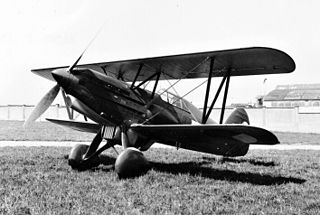
The Avia B-534 is a Czechoslovak biplane fighter developed and manufactured by aviation company Avia. It was produced during the period between the First World War and the Second World War. The B-534 was perhaps one of the most well-known Czechoslovakian aircraft of the era.

The Avia B.135 was a Czechoslovak cantilever monoplane fighter aircraft. It was the production version of the Avia B.35 developed shortly before the war, based on the B.35/3 prototype but featuring a new all-metal wing.
The Letov Š-16 was a Czechoslovak single-engined, two-seat biplane bomber. It was designed by Alois Šmolík at Letov Kbely. The Š-16 first flew in 1926.

The Letov Š-28 was a Czechoslovak single-engined, two-seat reconnaissance aircraft. It was manufactured by Letov Kbely in a number of versions with different powerplants. The most important version was the Š-328, which was produced in relatively high quantities.
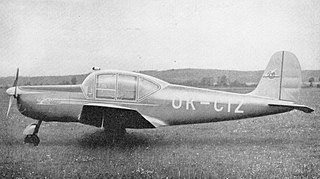
The Mráz M-3 Bonzo was a light aircraft built in Czechoslovakia in 1948 as a further development in the family of light aircraft that had commenced with the M-1 Sokol.
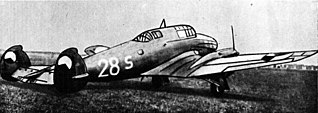
The Avia B.158 was a prototype Czechoslovak twin-engined light bomber aircraft of the 1930s. Only a single example was built and it was abandoned, following the German occupation of Czechoslovakia in March 1939.
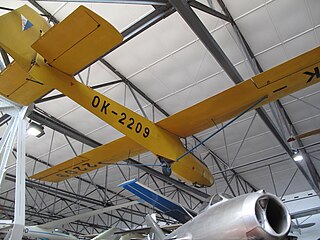
The Let LF-109 Pionýr is a glider aircraft developed by Czechoslovak manufacturer Let Kunovice. It was designed as a two-seater training aircraft and the first flight was performed in March 1950. The plane features a simple and robust design of a fabric-covered steel tube fuselage and has good flight characteristics. In total, about 470 aircraft were built.
The Moscow Aviation Institute BB-MAI was a Soviet light bomber/attack plane prototype aircraft. Designed in 1939 by Peter Grushin of the Moscow Aviation Institute, it was delayed by problems with the new Klimov M-105 engine and eventually only a single prototype was built. While the design was not accepted for serial production, it was the first Soviet aircraft to use a tricycle landing gear and one of the first to feature a supercharger and leading-edge slats.

The Beneš-Mráz Be-150 Beta-Junior was a light aerobatic trainer and racing aircraft, designed and built in Czechoslovakia in the late 1930s.

The LWF model V is an American two-seat reconnaissance and training biplane built during World War One, and used for a short period afterwards. A variant specially built to test the Liberty L-12 aircraft engine, the model F, was the first aircraft to fly powered by that widely used engine.

The Praga E-51 is a Czechoslovakian reconnaissance aircraft and light bomber built by Praga in the 1930s. Development was halted by the annexation of Czechoslovakia by Germany, after only one prototype had been built. The appearance of the construction is very reminiscent of the contemporary twin engined fighter, the Fokker G.I from Holland.

The Lazarov Laz-7 was a Bulgarian training aircraft of the 1940s and 50s. The first of three prototypes flew on 12 June 1948, and was followed by 160 production aircraft powered by a Czechoslovakian Walter Minor 6-III inline engine built from 1949 to 1952, and 150 Laz-7Ms powered by a Soviet Shvetsov M-11FR radial engine from 1952 to 1954. A single example of a four-seat light transport derivative, the Laz-8, was built in 1949. The Laz-7 and Laz-7M were used by the Bulgarian Air Force as a trainer and light bomber, and surplus examples were later transferred to flying clubs, were they remained in use until the late 1960s.


















